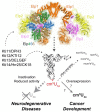Roles of Elongator Dependent tRNA Modification Pathways in Neurodegeneration and Cancer
- PMID: 30597914
- PMCID: PMC6356722
- DOI: 10.3390/genes10010019
Roles of Elongator Dependent tRNA Modification Pathways in Neurodegeneration and Cancer
Abstract
Transfer RNA (tRNA) is subject to a multitude of posttranscriptional modifications which can profoundly impact its functionality as the essential adaptor molecule in messenger RNA (mRNA) translation. Therefore, dynamic regulation of tRNA modification in response to environmental changes can tune the efficiency of gene expression in concert with the emerging epitranscriptomic mRNA regulators. Several of the tRNA modifications are required to prevent human diseases and are particularly important for proper development and generation of neurons. In addition to the positive role of different tRNA modifications in prevention of neurodegeneration, certain cancer types upregulate tRNA modification genes to sustain cancer cell gene expression and metastasis. Multiple associations of defects in genes encoding subunits of the tRNA modifier complex Elongator with human disease highlight the importance of proper anticodon wobble uridine modifications (xm⁵U34) for health. Elongator functionality requires communication with accessory proteins and dynamic phosphorylation, providing regulatory control of its function. Here, we summarized recent insights into molecular functions of the complex and the role of Elongator dependent tRNA modification in human disease.
Keywords: Elongator; U34; cancer; diphthamide; epitranscriptomics; neurodegeneration; tRNA; tRNA modification; wobble uridine modifications.
Conflict of interest statement
The authors declare no conflict of interest.
Figures


Similar articles
-
Use of a Yeast tRNase Killer Toxin to Diagnose Kti12 Motifs Required for tRNA Modification by Elongator.Toxins (Basel). 2017 Sep 5;9(9):272. doi: 10.3390/toxins9090272. Toxins (Basel). 2017. PMID: 28872616 Free PMC article.
-
Elongator, a conserved complex required for wobble uridine modifications in eukaryotes.RNA Biol. 2014;11(12):1519-28. doi: 10.4161/15476286.2014.992276. RNA Biol. 2014. PMID: 25607684 Free PMC article. Review.
-
Aspergillus fumigatus Elongator complex subunit 3 affects hyphal growth, adhesion and virulence through wobble uridine tRNA modification.PLoS Pathog. 2022 Nov 14;18(11):e1010976. doi: 10.1371/journal.ppat.1010976. eCollection 2022 Nov. PLoS Pathog. 2022. PMID: 36374932 Free PMC article.
-
tRNA binding to Kti12 is crucial for wobble uridine modification by Elongator.Nucleic Acids Res. 2025 Apr 10;53(7):gkaf296. doi: 10.1093/nar/gkaf296. Nucleic Acids Res. 2025. PMID: 40226916 Free PMC article.
-
Anticodon Wobble Uridine Modification by Elongator at the Crossroad of Cell Signaling, Differentiation, and Diseases.Epigenomes. 2020 May 12;4(2):7. doi: 10.3390/epigenomes4020007. Epigenomes. 2020. PMID: 34968241 Free PMC article. Review.
Cited by
-
Recent advances in the molecular understanding of medulloblastoma.Cancer Sci. 2023 Mar;114(3):741-749. doi: 10.1111/cas.15691. Epub 2022 Dec 25. Cancer Sci. 2023. PMID: 36520034 Free PMC article. Review.
-
Role of SSD1 in Phenotypic Variation of Saccharomyces cerevisiae Strains Lacking DEG1-Dependent Pseudouridylation.Int J Mol Sci. 2021 Aug 15;22(16):8753. doi: 10.3390/ijms22168753. Int J Mol Sci. 2021. PMID: 34445460 Free PMC article.
-
Identification of hub genes associated with head and neck squamous cell carcinoma by integrated bioinformatics approach and RNA-seq validation analysis.Am J Cancer Res. 2023 Apr 15;13(4):1259-1277. eCollection 2023. Am J Cancer Res. 2023. PMID: 37168331 Free PMC article.
-
Modifications of the human tRNA anticodon loop and their associations with genetic diseases.Cell Mol Life Sci. 2021 Dec;78(23):7087-7105. doi: 10.1007/s00018-021-03948-x. Epub 2021 Oct 4. Cell Mol Life Sci. 2021. PMID: 34605973 Free PMC article. Review.
-
tRNA Function and Dysregulation in Cancer.Front Cell Dev Biol. 2022 Jun 1;10:886642. doi: 10.3389/fcell.2022.886642. eCollection 2022. Front Cell Dev Biol. 2022. PMID: 35721477 Free PMC article. Review.
References
Publication types
Grants and funding
LinkOut - more resources
Full Text Sources

